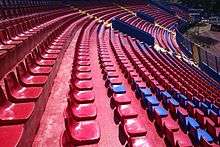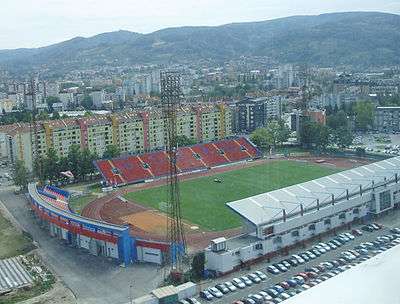Banja Luka City Stadium
|
Banja Luka City Stadium - UEFA | |
| Full name | Banja Luka City Stadium |
|---|---|
| Location | Banja Luka, Bosnia and Herzegovina |
| Coordinates | 44°46′34″N 17°11′59″E / 44.7761°N 17.1996°ECoordinates: 44°46′34″N 17°11′59″E / 44.7761°N 17.1996°E |
| Owner | Banja Luka |
| Operator | Borac Banja Luka |
| Capacity | 9,730 (seated) |
| Field size |
105 by 68 metres (114.8 × 74.4 yd) |
| Surface | Grass |
| Scoreboard | Yes |
| Construction | |
| Opened | 5 September 1937 |
| Expanded | 1973, 1981, 2010, 2012 |
| Architect | Žarko Malić |
| Tenants | |
| Borac Banja Luka (1937–present) | |
Banja Luka City Stadium (Serbian Cyrillic: Градски стадион Бања Лука) is a multi-purpose stadium in Banja Luka, Republika Srpska, in Bosnia and Herzegovina. It is currently used mostly for football matches and is the home ground of Borac Banja Luka.
History
Before World War I, football in Banja Luka was initially played in the area from the city. The population of the city were attracted more and more by football after the war, officials deemed the current facilities inadequate for a club with growing popularity. So, they have decided to build a new stadium with better conditions for playing and bigger capacity. The architect of a new stadium was Žarko Malić. The stadium was officially opened on 5 September, in 1937, with its first official name "Stadium of Bogoljub Kujundžić" in honor of Kujundžić, one of the main donator for the stadium. After the World War II, the stadium received its present name, the Banja Luka City Stadium.

The highest attendance on the stadium was recorded in 1989 when there was 30,000 people. The stadium underwent several expansions and reconstructions in the year 1973 and 1981, 2010 and 2012. The first match under reflectors was played on 11 October, in 1973. The east stand, where the most loyal fans, the Lešinari), are located, was built in 1981. In 2010, the stadium underwent complete reconstruction. New seats were installed, locker rooms were renovated, a completely new VIP lounge and media room was built, new lighting, sound systems and video surveillance were installed, and trophy as well technical rooms were renovated. In 2012, new north stand was built with a capacity of 2,492 seats, which increased the total capacity of stadium finally to 9,730. Today, the stadium meets UEFA demands for spectators comfort and security and it has separate section for guest fans. In its history, it has hosted numerous international matches at a senior level, athletes meetings, concerts of famous regional and worldwide stars and other manifestations. According to recent plans, the east stand will be covered by roof in upcoming years. In the near future, the construction of the south stand will begin, which would increase the total capacity to approximately 13,000 seats.
New Stadium
In 2008, expert committee has chosen the concept of building a new stadium. The new stadium will have 30,000 seats and whole complex will cover 205,000 square meters. It will include two additional football fields, tennis, basketball and volleyball courts. The cost of the whole project is estimated to be €50 million and it will meet the highest FIFA and UEFA demands.
References
External links
- Official website (in Serbian)
- Sport association Borac (in Serbian)
- Banja Luka City Stadium at eurorivals.net
- Banja Luka City Stadium on at stadiumdb.com
